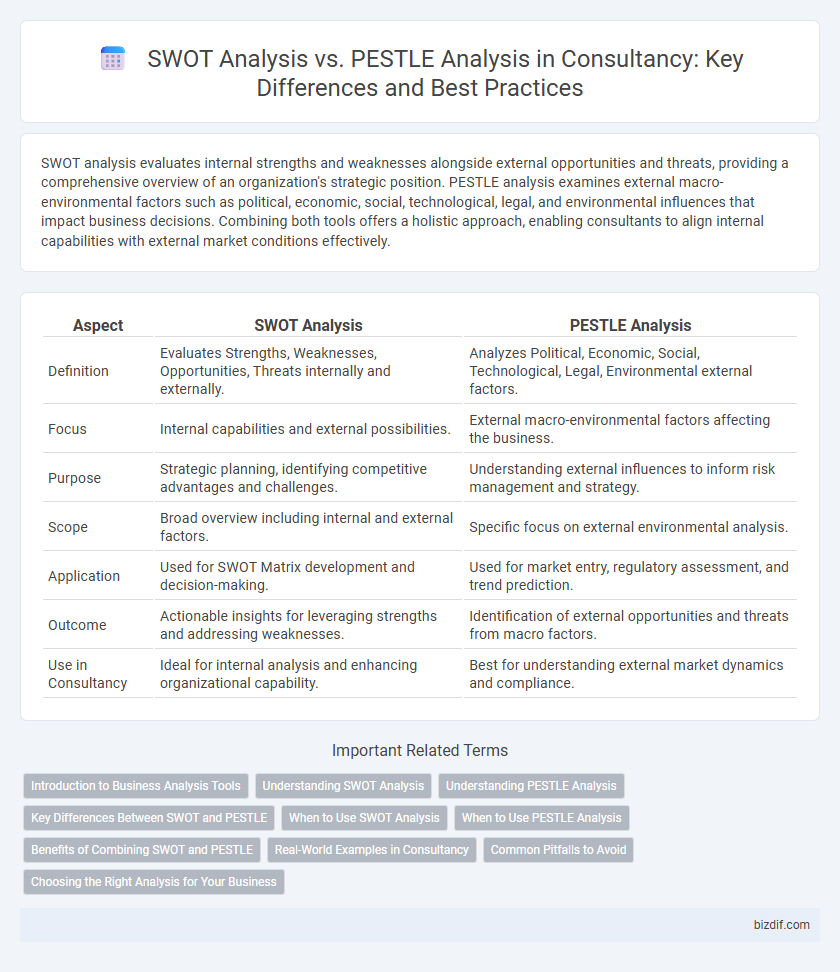SWOT analysis evaluates internal strengths and weaknesses alongside external opportunities and threats, providing a comprehensive overview of an organization's strategic position. PESTLE analysis examines external macro-environmental factors such as political, economic, social, technological, legal, and environmental influences that impact business decisions. Combining both tools offers a holistic approach, enabling consultants to align internal capabilities with external market conditions effectively.
Table of Comparison
| Aspect | SWOT Analysis | PESTLE Analysis |
|---|---|---|
| Definition | Evaluates Strengths, Weaknesses, Opportunities, Threats internally and externally. | Analyzes Political, Economic, Social, Technological, Legal, Environmental external factors. |
| Focus | Internal capabilities and external possibilities. | External macro-environmental factors affecting the business. |
| Purpose | Strategic planning, identifying competitive advantages and challenges. | Understanding external influences to inform risk management and strategy. |
| Scope | Broad overview including internal and external factors. | Specific focus on external environmental analysis. |
| Application | Used for SWOT Matrix development and decision-making. | Used for market entry, regulatory assessment, and trend prediction. |
| Outcome | Actionable insights for leveraging strengths and addressing weaknesses. | Identification of external opportunities and threats from macro factors. |
| Use in Consultancy | Ideal for internal analysis and enhancing organizational capability. | Best for understanding external market dynamics and compliance. |
Introduction to Business Analysis Tools
SWOT Analysis identifies internal strengths and weaknesses alongside external opportunities and threats, enabling businesses to assess their current position effectively. PESTLE Analysis examines external macro-environmental factors--Political, Economic, Social, Technological, Legal, and Environmental--that impact strategic decision-making. Both tools provide complementary insights essential for comprehensive business analysis and strategic planning.
Understanding SWOT Analysis
SWOT Analysis identifies internal strengths and weaknesses alongside external opportunities and threats, enabling businesses to leverage core competencies and address vulnerabilities. This method centers on strategic planning by aligning organizational capabilities with market conditions. Effective use of SWOT drives informed decision-making and competitive advantage in consultancy projects.
Understanding PESTLE Analysis
PESTLE Analysis evaluates the external macro-environmental factors impacting an organization, including Political, Economic, Social, Technological, Legal, and Environmental influences. This strategic tool helps consultants identify potential threats and opportunities stemming from market conditions, regulatory changes, and technological advancements. Unlike SWOT, which focuses on internal strengths and weaknesses, PESTLE provides a comprehensive framework for understanding external forces shaping business strategy.
Key Differences Between SWOT and PESTLE
SWOT analysis evaluates internal strengths and weaknesses alongside external opportunities and threats, offering a clear view of an organization's current position. PESTLE analysis examines external macro-environmental factors: Political, Economic, Social, Technological, Legal, and Environmental influences that impact strategic decisions. The key difference lies in SWOT's internal-external focus versus PESTLE's exclusive emphasis on external environmental scanning.
When to Use SWOT Analysis
SWOT analysis is most effective during the initial stages of strategic planning to identify internal strengths and weaknesses alongside external opportunities and threats. It provides a concise framework for evaluating a company's competitive position, making it ideal for decision-making in resource allocation and risk management. Organizations use SWOT analysis when they need a clear snapshot of current capabilities and external factors driving potential growth or challenges.
When to Use PESTLE Analysis
PESTLE analysis is essential for understanding the macro-environmental factors impacting a business, including political, economic, social, technological, legal, and environmental influences. It is most effective during the early stages of strategic planning or market entry to identify external opportunities and threats. Companies facing uncertain regulatory landscapes or significant market shifts benefit from PESTLE's comprehensive external focus over SWOT's internal-external balance.
Benefits of Combining SWOT and PESTLE
Combining SWOT and PESTLE analyses offers a comprehensive consultancy approach by integrating internal strengths and weaknesses with external political, economic, social, technological, legal, and environmental factors. This dual framework enhances strategic decision-making, enabling businesses to identify opportunities and mitigate threats with greater precision. Utilizing both analyses together empowers consultants to develop robust, context-aware strategies that drive sustainable growth and competitive advantage.
Real-World Examples in Consultancy
SWOT Analysis identifies internal strengths and weaknesses alongside external opportunities and threats, making it ideal for consultancy projects assessing company capabilities, such as a retail chain expanding into new markets. PESTLE Analysis examines external macro-environmental factors--Political, Economic, Social, Technological, Legal, and Environmental--used by consultants advising multinational corporations navigating regulatory changes across countries. Real-world consultancy cases often integrate both tools, for example, a technology firm's market entry strategy leveraging SWOT to assess internal readiness while using PESTLE for external risk evaluation.
Common Pitfalls to Avoid
Common pitfalls in SWOT analysis include vague or overly broad categories, neglecting to prioritize key factors, and ignoring external influences outside the immediate control of the organization. PESTLE analysis often fails when analysts overlook emerging trends, blend factors inappropriately, or disregard the interconnected impact of political, economic, social, technological, legal, and environmental elements. Effective consultancy leverages precise data segmentation and continuous updates to ensure both frameworks provide actionable insights without bias or oversimplification.
Choosing the Right Analysis for Your Business
SWOT Analysis focuses on identifying internal strengths and weaknesses alongside external opportunities and threats, making it ideal for understanding company-specific factors and strategic positioning. PESTLE Analysis examines macro-environmental influences including Political, Economic, Social, Technological, Legal, and Environmental factors, providing a broader context for external risks and market trends. Choosing the right analysis depends on whether your business needs deep internal insights for competitive advantage or a comprehensive overview of external forces shaping the industry landscape.
SWOT Analysis vs PESTLE Analysis Infographic

 bizdif.com
bizdif.com